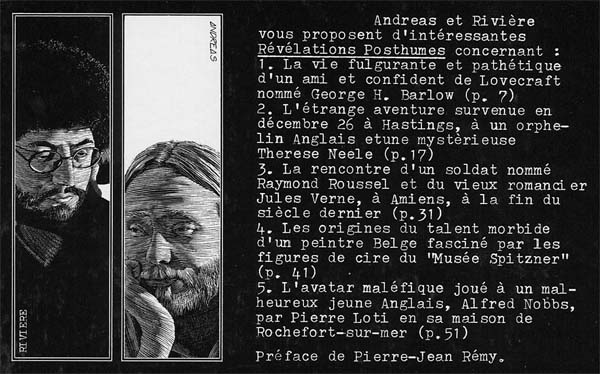
What happened after Saint-Luc and the Academy?
Andreas: Yet I hold good memories on Saint-Luc, because of the
friends and aquaintances it has left me. We shared the same passion,
we all wanted to do comics. After Saint-Luc I worked with Antonio Cossu,
Philippe Foerster and Philippe Berthet for - I don't remember exactly how long
- six to twelve months. We had rented some space and made a workshop out of it.
We had much fun. We discussed eachother's work, that was a lot of fun.
Talking to comic book artists these days, its always about rights of
authorship, contracts and the like. It's no longer about what's really
interesting about the trade.
You worked in the same space, yet everyone had his own work...
Andreas: Everyone did his own thing. We just started. I drew the
first episode of Révélations posthumes in collaboration with François Rivière
and made sketches for Eddy Paape. Antonio Cossu made drawings and the
layout for a small business magazine. Philippe Berthet and Philippe Foerster
worked on a book about hunting in Belgium; Berthet drew the animals and
Foerster did the backgrounds and characters. That was the beginning,
we became professional slowly but certainly. Then followed the first
festivals of Angoulême, where we made our first important contacts...
--- part of article left out here ---
Andreas: The first episode of Révélations posthumes I made in 1977 and
these were published the year after in (A Suivre).
The contact with François Rivière
comes from that famous day when Jijé visited the Saint-Luc.
I had a drawing on (site-editor: in Dutch: schaafkarton), my first. That happened to be the only
one of which Jijé had said:""That's good! Look, that is good,
elegant..." Rivière was there as well. He was looking for someone
to do the cover of a Jules Verne book and approached me. Later I asked
him to write a story for me. I believe he didn't feel like it at first,
but I persisted, so eventually he came up with a text on H.P. Lovecraft.
After he had seen the first plates, he became more interested. At first we
worked for Métal Hurlant, for a Lovecraft special. But when I was
finished, Riviere told me: "Métal Hurlant isn't doing well these days,
they don't pay well. Maybe it would be better to go to
(A Suivre)." I must say I didn't feel good about this thing with
Métal Hurlant. That also led to some arguments. Later I understood that
it was really something for (A Suivre). They were looking exactly for
this mixture of comics and literature. After that we continued working for
them. Métal Hurlant was a lost case in all respects.
--- part of article left out here ---
Andreas: Yes I worked a long time on Révélations posthumes, especially on
those stories on Loti and H.P. Lovecraft. I was very careful, because
I didn't really know what I was doing. I spent much time on them.
Révélations posthumes has become an odd album, but I don't really think it's good.
It's not really a strip, more like an overillustrated text, mainly because of
the photographs I used, which I did partially to work faster.
And of course my drawing style was not great.
Did you work out the text based on the photos? Or did you look for photos
to match the texts?
Andreas: I looked for photos to match the text. For some stories we made
photos ourselves, like stories on Jule Verne or Loti. For La femme de cire du musée Spitzner
we visited the museum more than once. It happened to be in France and later in
Belgium. The story on Agatha Christie I made with photos from a book
François Rivière lent me and other things I found myself. Eventually it
became routine and we stopped it.
| 